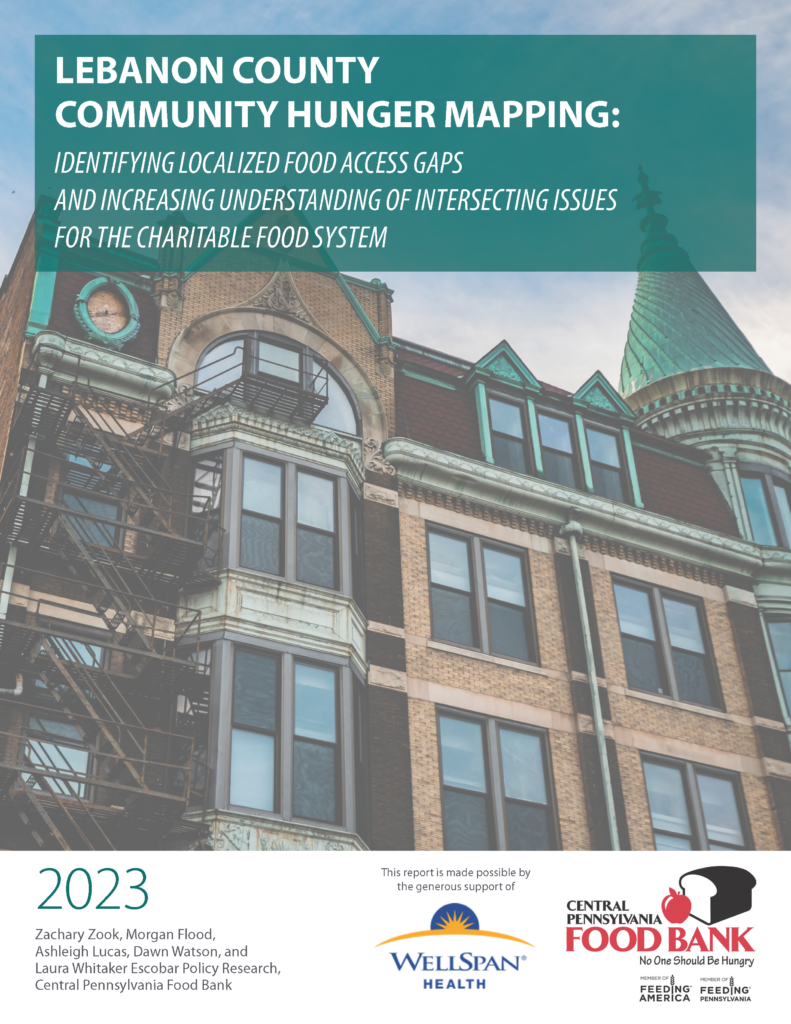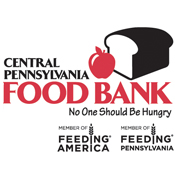Lebanon County Hunger Mapping
One in ten (9.8%) Lebanon County residents experiences food insecurity, and a similar proportion (9.7%) visited a food pantry in the last year. In total, nearly 14,000 individuals in the county are impacted by food insecurity and the charitable food network’s response to it. Importantly, food insecurity does not impact people of all ages, household types, geographies, or race/ethnicities equally. With this understanding, this report assesses the causes and distribution of these differences and discusses ways stakeholders can work to reduce these inequities.
Given a problem of this breadth and complexity, it is critically important for stakeholders in the charitable food network to better understand the issues at play. This report aims to provide that understanding and to chart a path forward to reducing food insecurity in the near and long-term.
The voices of neighbors who currently experience food insecurity, as gathered through surveys conducted at food pantries and community locations, one-on-one interviews, and focus groups, are spotlighted throughout this report. Through agency surveys and interviews, the perspectives of charitable food providers are also included. Alongside these qualitative methods, innovative quantitative analyses regarding access to pantries across a variety of metrics and participation in government programs at sub-county and pantry levels are also used, resulting in a final report that leverages a mixed-methods approach that brings both quantitative rigor and robust qualitative components. All this work was done with the specific aim of listening deeply to food insecure neighbors in Lebanon County and bringing their thoughts, ideas, and needs to the fore.
Merely understanding the causes and scope of food insecurity in Lebanon is not enough to create a county where no one is hungry. To help make progress toward that goal, this report also provides actionable recommendations around better serving and improving the experiences of the neighbors who utilize Lebanon County’s charitable food network in the short term as well as eliminating food insecurity in the long term.
Meaningful progress toward ending hunger will require intentional, sustained collective efforts by the entire Lebanon County community, including social service organizations, health systems, government officials, concerned citizens, and more. Throughout this work, the Lebanon County charitable food network will build on its existing strengths while seeking continuous improvement as it strives to ensure that everyone in the county has enough nutritious food to live a healthy life, free of worry about how they will get their next meal.
The main research questions that this report seeks to address are as follows:
- What is the extent of food insecurity in Lebanon County, and where in the county is it concentrated?
- Who in Lebanon County is most impacted by food insecurity? How do food insecurity rates and the main drivers of food insecurity differ by age, race and ethnicity, or other factors?
- How accessible is charitable and retail food in Lebanon County and how does access vary in different areas of the county? How does access vary, if at all, by demographics?
- What barriers do neighbors face in accessing charitable food services? Where do food distribution and access gaps exist in Lebanon County? What is the neighbor experience at food pantries like?
- What are utilization rates of key government nutrition related assistance programs and how do they vary across the county? What is the charitable food system’s role in this space?
- What other issues impact food insecurity in Lebanon County? What can the charitable food system and other relevant stakeholders do to better address the root causes of food insecurity?
View An Interactive Copy of the Full Report Below
or CLICK HERE to Download
Key Findings 1. Focusing on Improving the Neighbor Experience, Building on Best Practices, and Increasing Capacity Investments within the Charitable Food System in Lebanon County
The charitable food system reduces very low food security. Rates of very low food security in Lebanon County fall when pantry visitors report utilizing the charitable food system more frequently, holding key factors such as income and SNAP participation constant. Utilization of the charitable food system is impacted by pantry policies, pantry capacity, and the neighbor experience when visiting food pantries. Each of these factors impacts people’s willingness and ability to use the charitable food system.
Improving the Neighbor Experience: A sizable percentage of neighbors (as high as 10% at certain pantries and 6% on average) report negative experiences with the charitable food system and can recount specific negative experiences. Focusing on the neighbor experience is not tangential to traditional charitable food system work. It is essential in ensuring that neighbors do not go hungry.
The frequency with which people are willing to utilize the charitable food system is directly impacted by the neighbor experience at food pantries, as interviewees and focus group participants reported not visiting pantries for long periods of time after particularly negative experiences with volunteers and staff. Improving the neighbor experience at food pantries will require a multi-faceted approach. The food pantry experience is impacted by both the built pantry environment and the behaviors of the individuals staffing the pantries.
Four of the main components of improving the neighbor experience include:
- The charitable food system should develop and implement pantry volunteer and staff trainings to set expectations of behavior and treatment and to empower pantry workers with trauma-informed care practices that equip them to treat all neighbors with dignity and respect. Pantry coordinators should also assess volunteer suitability for neighbor-facing roles and re-assign them as appropriate.
- Extended wait times and long lines are also a neighbor experience issue across food pantries in Lebanon County. The wait time and line experience are often worsened by being outside, even in inclement weather. Pantries should work to reduce lines by ensuring that the quality and quantity of food offerings are similar from the start to end of a distribution and by testing appointment methods while retaining flexibility for pantry visitors. Pantries should work in the immediate term to move lines inside, as neighbors reported that inclement weather can be dangerous for their health and prevent them from visiting a pantry even when they need help.
- Hispanic and Asian households are the least likely to report finding foods they desire “often or always” at food pantries. Pantries should solicit food preference feedback from neighbors and the larger charitable food system should support efforts to provide requested foods more regularly.
- One third of individuals who screened as food insecure in non-food pantry surveys reported not knowing where to find a food pantry. This is a clear opportunity to increase awareness of pantry offerings in public places such as libraries, government offices, and other key locations.
Building on Best Practices: Pantry policies in Lebanon County are generally in line with best practices across the broader charitable food network; many pantries offer choice models, provide evening and/or weekend access, and allow households to visit regardless of income. Furthermore, pantries in Lebanon County allow neighbors to visit twice per month or more, which increases the accessibility of charitable food and allowed CPFB researchers to determine the marginal impact of additional food pantry visits on very low food security status. While these procedures and policies are a significant strength of the Lebanon County charitable food system overall, there is still room for improvement in areas like distribution model and weekend hours access at specific pantries.
Capacity Investments: Lebanon County has relatively few food pantries available per food insecure individual. Pantries report difficulty sourcing adequate amounts of quality and diverse food to meet high levels of demand, difficulty with volunteer capacity, and overall difficulty with sufficient resources to meet the high level of need. The relatively low number of pantries available means stakeholders should invest further in existing pantries and consider other ways to increase access, such as additional pantry locations, mobile locations, or pop-up distributions, among other strategies.
Key Findings 2. SNAP Participation and Utilization of Key Government Programs
The charitable food system and SNAP are inextricably linked, as a 41% drop in SNAP benefits in the first half of 2023 corresponded directly with a 39% increase in visits to food pantries in the county. SNAP participation cuts very low food security rates by nearly half (45%) among food pantry visitors in Lebanon County when holding incomes below the poverty level and pantry visit frequency constant.
SNAP participation is just 45% among food pantry visitor households and is middling across the entire county, leaving significant room for improvement.
Increased outreach to drive additional SNAP participation will likely reduce very low food security further among both food pantry visitors and food insecure households who do not utilize the charitable food system. County stakeholders should establish strong relationships with food pantries, healthcare organizations, the county assistance office, and other social services providers to provide clear directions and SNAP application assistance. There is a reported need to make SNAP eligibility requirements less confusing and daunting as well as to ease application burdens. Other key government nutrition programs such as WIC and school breakfast and lunch programs are also underutilized. Testing and implementing innovative methods to expand outreach and participation would have a significant impact on very low food security across the county, especially among children, who are the most likely to experience food insecurity in Lebanon County.
Key Findings 3. Household income and systemic economic factors such as financial exclusion, housing burdens, low wages, and transportation impact very low food security significantly.
Income is one of the most important factors that impact a pantry visitor’s household food security status, but 40% of those households who work full time earn less than the federal poverty level. Irregular and inconsistent hours have a major impact on total monthly earnings and corresponding food security status, as households who report “no weeks not working” in the last year have poverty rates close to half of households with less reliable work arrangements. Stakeholders should advocate for family sustaining wages and for increased consistency in working schedules.
Over half of pantry visitor households report choosing between food and utilities or rent/mortgage, which were the most highly reported economic trade-offs. A total of 8% of households have been forced to move in the last year, and 20% are worried about being forced to move in the next year. The charitable food system should provide foods suitable to marginally housed individuals, as well as continue and expand utility and housing assistance programs where possible.
Over half of pantry visitors do not drive to their food pantry, and a fifth of households report difficulty getting to a pantry due to transportation issues. These neighbors likely also face compounding issues related to transportation in other areas of their lives. Pantries could work to address transportation barriers by experimenting with delivery models or opening mobile distributions.
Nearly a quarter of pantry visitor households do not have a high school diploma. Survey results indicate that neighbors are interested in continuing educational opportunities; pantries should consider partnering with community organizations that offer resources like GED courses or career development training.
More than 40% of pantry visitor households are unbanked (27%) or underbanked (14%), which reduces the economic mobility pathways available to food insecure households in Lebanon County. Food pantries have an opportunity to partner with financial institutions to increase access to checking and savings accounts, especially around “bankable” moments such as tax time.
Interactive Map of Food Insecurity in Lebanon County
Made Possible by the Generous Support of



